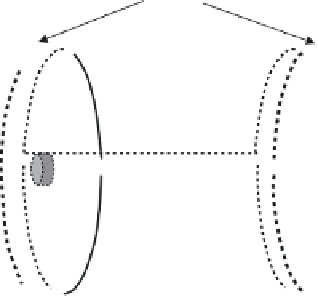Chemistry Reference
In-Depth Information
of protein-ligand noncovalent complexes will be presented. The FTMS mass analyzer is
typically a cylindrical-shaped cell capped by plates known as trapping plates; the cylinder
walls are divided into four quadrants. Opposing pairs of plates in the four quadrants are
known as the excite plates and detect plates (Figure 7.7). This cell is locatedwithin a vacuum
chamber that is housed inside the homogeneous magnetic field region of a superconducting
solenoid magnet. The basic equation of ion motion in FTMS is
F
=
q
v
×
B
(7.5)
where
F
is the force on the ion,
v
is the velocity of the ion and
B
is the applied magnetic
field from the superconducting magnet that lies along the axis of the cylindrical analyzer
cell and
q
is the charge on the ion (variables in bold font are vector variables). The ion
motion equation cross product is zero when the velocity vector of the ion is parallel to
the magnetic field. In a physical sense, this means that the ions are unconstrained by the
magnetic field as they move along the central axis of the cylindrical mass analyzer cell. For
this reason, a 'trapping' voltage, typically about
1.0 V, is applied to the trapping plates (a
positive trapping voltage for positive ions or a negative trapping voltage for negative ions)
to hold ions in the analyzer cell. For velocity components of ions that are not parallel to
the magnetic field, the ions experience a force perpendicular to both the magnetic field and
the velocity vector of the ions, which causes them to move in a circular path around the
magnetic field axis and is known as cyclotron motion (Figure 7.7).
+
Trapping Plates, +1.0
V
Detection
B
F
=
q
v
´
B
+
Excitation
Figure 7.7
An FTMS mass analyzer cell depicting the motion of trapped ions in the presence
of the magnetic field.
The radius of the cyclotron motion depends on the energy of the ions. Ions are typically
injected into the mass analyzer cell with low energies, resulting in small initial cyclotron
radii of 0.01-0.1 mm. The frequency
f
of the cyclotron motion is
f
=
qB/
2
πm
(7.6)
where
B
is the magnetic field strength in tesla,
q
is the charge on the ion and
m
is the
mass of the ion [Equation (7.6) describes the ideal situation, i.e. with no applied electric









